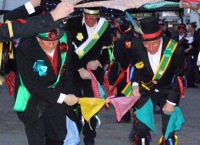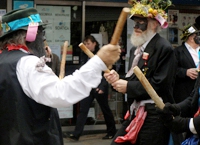The Morris When it began: Molly Dancing Early records suggest a connection with May and Whitsun festivals, with Morris dancers involved in events set by the Church calendar, possibly as a way of bringing a popular entertainment under ecclesiastical control. For example, the style called "Molly Dancing" from the Eastern counties of England was always associated with the Church's Plough Sunday celebration and Plough Monday. Posh Entertainment: Over time the custom spread to other times of year, and in the 16th Century Morris became a fashionable entertainment for the Court and the aristocracy, with teams sponsored by the wealthy. From this upper-class popularity, the Morris spread more widely among the gentry, out of London and up the Thames Valley into the Cotswolds, and so further afield, becoming a pastime based in the villages, closely allied with village events. What’s in a name?  Border Morris There are other views, but whatever its origins, the Morris has been subject to many influences, changing and developing over the years. Styles of Morris & Traditional Dance:  Rapper Sword Dancers Where modern Morris comes from: Many Cotswold village teams had their own dances, but by the end of the 19th century Morris was in decline and many dances were lost as teams died out. It was only traditional music collector Cecil Sharp's chance encounter with the Headington Quarry men on Boxing Day 1899 which sparked a revival, as Sharp and later his colleagues noted dances and tunes from old dancers in the villages, and published them in a deliberate attempt to revive the tradition. The English Folk Dance Society, now the EFDSS, organised training and teaching during the first decades of the 20th Century. The Morris Revival:  North West Morris Most of the men's teams like Anker Morris Men belong to the Morris Ring, formed in 1934 to further the fellowship and traditions of the Morris. Every year the Morris Ring sponsors several Meetings where usually ten or twelve teams get together to display the Morris to the public. Varied Morris: The revival produced many teams of women dancers, and mixed teams, who have their own national organisations, the Morris Federation and the Open Morris. Most teams join with others around the country for days and weekends of dance, as well as appearing at local venues as we do, and the Morris organisations co-operate to present a joint display annually, where teams from all three perform. A Living Tradition:  Longsword Dancers We hope you take pleasure in watching us and sharing in a living part of England's heritage. |    |

